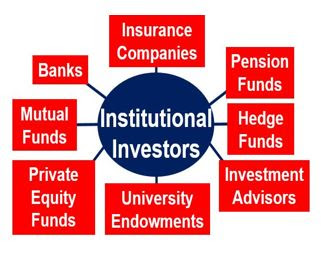Financial English Course Unit Six
Institutional Investor, Merger and Acquisition, and Arbitrage
Institutional Investor, Merger and Acquisition, and Arbitrage
Хичээл 6 Институцийн(байгууллагын хөрөнгө оруулагчид) хөрөнгө оруулагчид ба Компанийг худалдан авах ба нэгдэл, арбитраж
Exercise
Match these institutional investor terms with definition below
Endowments bank trust departments Private pension funds Foundations
Investment companies Life insurance companies institutional investors
|
The market of 1………………….. is made up of investment companies (closed-end and mutual funds), pension funds, insurance companies, foundations, endowments, and other participants. 2…………………… take the proceeds of individual investors and reinvest them in other securities according to their specific objectives. 3……………………. represent well over half of the pension fund market. 4…………………. must earn a minimum rate on return assumed in calculating insurance premiums, and public policy emphasizes safety of assets. The emphasis in 5…………….. is on managing other people’s funds for a fee. 6………………….. represent nonprofit organizations set up to accomplish social, educational or charitable purposes. 7………………., on other hand, represent permanent capital funds that are donated to universities, churches or civic organizations.
Answer to exercise
1. Institutional investors
2. Investment companies
3. Pension fund
4. Insurance companies
5. Bank trust departments
6. Foundations
7. Endowments
Vocabulary
Institutional investor – институцийн хөрөнгө оруулагчид
Made up of – бүрдэх
Investment companies – хөрөнгө оруулалтын компаниуд
Closed end – хаалттай
Mutual fund – хамтын сан
Pension fund – тэтгэвэрийн сан
Foundations - сан
Endowments – хандивын сан
Proceeds – орлого
Insurance premiums – даатгалын зардал
Safety of assets – хөрөнгийн найдвартай байдал
Donate - хандивлах
Speaking Mergers and acquisitions
Peter Sinclair: Well, the role of the investment banks; yes, they are certainly big, important players in mergers and acquisitions, and yes, they may sometimes try and drum up business, but I think that no well-run firm will want to engage in this kind of activity unless they see merit in doing so. So it isn’t all driven by the banks. What we do note – and that is really interesting – is that when a company goes for a takeover, tries to take over another, the thing that’s most important is its share price, the share price of the company doing the takeover. So if the share prices do well – which they did in the 80s and 90s, most of the time – companies feel richer, their shares are more valuable, so they tend to go out on a buying spree and they will get advice from big investment banks and merchant banks about when to buy and what to buy. And the potential victim of a takeover bid will obviously want to get advice from another national institution about how to defend itself, assuming that’s what it wants to do.
So we’ve seen a lot of acquisitions and mergers, some friendly mergers and some contested takeovers, a lot of them happening in a strong stock market. In the early twenty-first century, so far, we have been seeing share prices slide a bit and so mergers and acquisitions are becoming less frequent and of course less valuable. The value of companies has fallen so the value of the activity for the merchant banks, investment banks, has been slipping too. It is very much a cyclical phenomenon-boom for shares means more takeover, slump for shares means less.
Vocabulary
Acquisition – худалдан авах
Merger – нэгдэл
Drum up – өсөх
Takeover –(худалдан авалт хийж буй компани нь нэгдэн орж буй компанид санал тавих үйл явц юм) Эзэмших,
Buying spree – худалдан авах
Merchant bank – арилжааны банк(British english)
Contested – өрсөлдөх
Boom – огцом өсөлт
Slump – буурах
Victim – зорилтот зах зээл
Translating Arbitrage
Arbitrage is the simultaneous purchase or sale of a commodity in different markets to profit from unwarranted differences in prices. That is, it involves the purchase of a commodity, including foreign exchange, in one market at one price while simultaneously selling that same currency in another market at a more advantageous price, in order to obtain a risk-free profit on the price differential. Profit is the price differential minus the cost. If exchange rates are not equal worldwide, there would be profit opportunity for simultaneously buying a currency in one market while selling it in another. This activity would raise the exchange rate in the market where it is too low, because this is the market in which you would buy, and the increased demand for the currency would result in a higher price. The market where the exchange rate is too high is one in which you sell, and this increased selling activity would result in a lower price. Arbitrage would continue until the exchange rates in different markets are so close that it is not worth the costs incurred to do any further buying and selling. When this situation occurs, we say that the rates are “transaction costs close.” Any remaining deviation between exchange rates will not cover the costs of additional arbitrage transactions, so the arbitrage activity ceases.
Орчуулах нь
1. Arbitrage is the simultaneous purchase or sale of a commodity in different markets to profit from unwarranted differences in prices.
(Arbitrage is the simultaneous purchase or sale of a commodity in different markets)2 (to profit from unwarranted differences in prices)1.
Арбитраж бол үнийн тодорхойгүй зөрүүнээс ашиг олох зорилгоор өөр зах зээлүүдэд бараа түүхий эдийг нэгэн зэрэг худалдах, худалдан авах үйл явц юм.
2. That is, it involves the purchase of a commodity, including foreign exchange, in one market at one price while simultaneously selling that same currency in another market at a more advantageous price, in order to obtain a risk-free profit on the price differential.
Үнийн ялгаатай байдлаас эрсдэлгүй ашиг олох зорилгоор ижил валютыг нэг зах зээлээс давуу тал буюу хамгийн бага үнээр нэгэн зэрэг худалдан авахын сацуу өөр зах зээлээс гадаад валют оролцуулан бараа, түүхий эдийг худалдан авах үйл ажиллагаа үүнд бас хамарна.
3. Profit is the price differential minus the cost.
Ашгийг үнийн ялгавараас зардлыг хасаж тооцдог.
4. If exchange rates are not equal worldwide, there would be profit opportunity for simultaneously buying a currency in one market while selling it in another.
(If exchange rates are not equal worldwide), (there would be profit opportunity for simultaneously buying a currency in one market)3 (while selling it in another)2.
Ханш нь дэлхийн хэмжээнд ижил биш бол валютыг нэг зах зээлд худалдахын сацуу нөгөө зах зээлээс нэгэн зэрэг худалдан авахад ашигтай байж болно.
5. This activity would raise the exchange rate in the market where it is too low, because this is the market in which you would buy, and the increased demand for the currency would result in a higher price.
(This activity would raise the exchange rate in the market (where it is too low)3)4, (because this is the market in which you would buy)1, and the increased demand for the currency would result in a higher price))2.
Энэхүү үйл ажиллагаа нь ханш багатай зах зээлийн ханшийг нь нэмэгдүүлдэг учир валютын эрэлтийг нэмэгдүүлсэнээр ханшийг нь өсгөдөг.
6. The market where the exchange rate is too high is one in which you sell, and this increased selling activity would result in a lower price.
Ханш нь өндөр байгаа зах зээлээс валют худалдан авч үнийг бууруулах нөхцөл бүрдэнэ.
7. Arbitrage would continue until the exchange rates in different markets are so close that it is not worth the costs incurred to do any further buying and selling.
Цаашид худалдах болон худалдан авахад ямар нэг зардал гаргах боломжгүй байхаар өөр зах зээлүүд дэх ханш нь ижил болох хүртэл арбитраж хийх боломжтой байна.
8. When this situation occurs, we say that the rates are “transaction costs close.”
Ийм нөхцөл байдал үүсэхэд ажил гүйлгээний зардал нь ижил нөхцөл ханшийн хувьд үүснэ.
9. Any remaining deviation between exchange rates will not cover the costs of additional arbitrage transactions, so the arbitrage activity ceases.
Ханшийн хоорондын үлдэж буй зөрүү нь арбитраж хийх нэмэлт зардлыг шингээж чадахгүй учираас арбитраж хийх боломжгүй болно.
Problem solution
Killer Shark Inc. makes a surprise cash offer of $22 a share for Goldfish Industries. Before the offer, Goldfish was selling for $18 a share. Goldfish has 1 million shares outstanding. What must Killer Shark believe about the present value of the improvement it can bring to Goldfish operations?
The cost of the merger is $4 million: the $4 per share premium offered to Goldfish shareholders times 1 million shares. If the merger has positive NPV to Killer Shark, the gain must be greater than $4 million.




